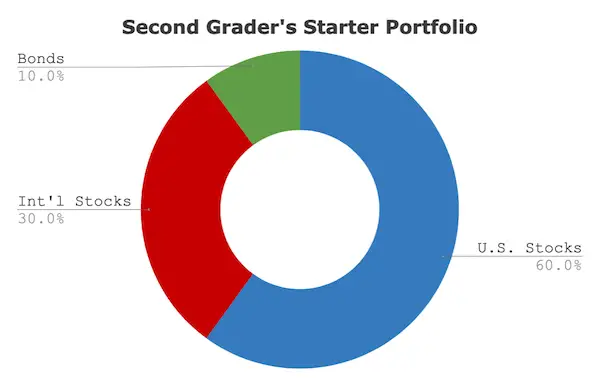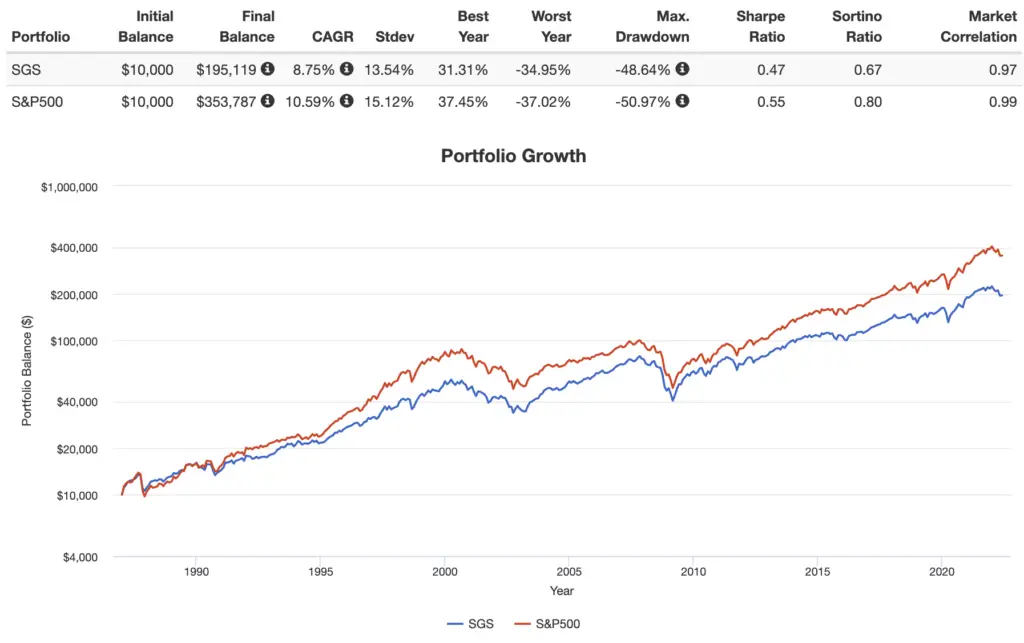The Second Grader's Starter Portfolio is comprised of U.S. stocks, international stocks, and U.S. bonds. Here we’ll take a look at its components, performance, and the best ETF’s to use in its execution.
Interested in more Lazy Portfolios? See the full list here.
Disclosure: Some of the links on this page are referral links. At no additional cost to you, if you choose to make a purchase or sign up for a service after clicking through those links, I may receive a small commission. This allows me to continue producing high-quality content on this site and pays for the occasional cup of coffee. I have first-hand experience with every product or service I recommend, and I recommend them because I genuinely believe they are useful, not because of the commission I may get. Read more here.
Contents
Video
Prefer video? Watch it here:
What is the Second Grader's Starter Portfolio?
The Second Grader's Starter Portfolio is a lazy portfolio created by financial columnist Paul Farrell. The portfolio is essentially a Bogleheads 3 Fund Portfolio.
Farrell proposed that the Second Grader's Starter Portfolio, as the name implies, is a good “starter” portfolio for a young investor with a long investing horizon, using the example of a 2nd-grader who receives a $10,000 gift from his grandmother to invest.
The Second Grader's Starter Portfolio utilizes broad index investing for diversification as follows:
- 60% Total U.S. Stock Market
- 30% Total International Stock Market
- 10% Total U.S. Bond Market

Second Grader's Starter Portfolio Performance Backtest vs. the S&P 500
Going back to 1987, here's the Second Grader's Starter Portfolio's performance vs. an S&P 500 index fund through 2021:

Compared to the S&P 500 index, the Second Grader's Starter Portfolio has delivered lower general and risk-adjusted returns (Sharpe, Sortino), with volatility only slightly lower than the S&P 500. This makes sense, as small-cap stocks and international stocks have suffered in recent years.
I actually like the portfolio's allocation to international stocks, providing a diversification benefit. Where I disagree with the Second Grader's Starter Portfolio is the prescription for a total bond market fund, because of the premise of the portfolio being for a young, new investor.
A young investor with a long investing horizon can afford to utilize longer-term bonds, especially since the bond holding is small at 10%. Specifically, long-term treasury bonds would be my choice, since they would offer better diversification and are superior to corporate bonds. Keep in mind a total bond market fund will usually have about 30% allocated to corporate bonds.
Second Grader's Starter Portfolio ETF Pie for M1 Finance
M1 Finance is a great choice of broker to implement the Second Grader's Starter Portfolio because it makes regular rebalancing seamless and easy, has zero transaction fees, and incorporates dynamic rebalancing for new deposits. I wrote a comprehensive review of M1 Finance here.
Using entirely low-cost Vanguard funds, we can construct the Second Grader Starter's Portfolio pie like this:
- VTI – 60%
- VXUS – 30%
- BND – 10%
You can add the Second Grader's Starter Portfolio pie to your portfolio on M1 Finance by clicking this link and then clicking “Save to my account.”
Disclosure: I am long VXUS.
Interested in more Lazy Portfolios? See the full list here.
Disclaimer: While I love diving into investing-related data and playing around with backtests, this is not financial advice, investing advice, or tax advice. The information on this website is for informational, educational, and entertainment purposes only. Investment products discussed (ETFs, mutual funds, etc.) are for illustrative purposes only. It is not a research report. It is not a recommendation to buy, sell, or otherwise transact in any of the products mentioned. I always attempt to ensure the accuracy of information presented but that accuracy cannot be guaranteed. Do your own due diligence. I mention M1 Finance a lot around here. M1 does not provide investment advice, and this is not an offer or solicitation of an offer, or advice to buy or sell any security, and you are encouraged to consult your personal investment, legal, and tax advisors. Hypothetical examples used, such as historical backtests, do not reflect any specific investments, are for illustrative purposes only, and should not be considered an offer to buy or sell any products. All investing involves risk, including the risk of losing the money you invest. Past performance does not guarantee future results. Opinions are my own and do not represent those of other parties mentioned. Read my lengthier disclaimer here.

Are you nearing or in retirement? Use my link here to get a free holistic financial plan and to take advantage of 25% exclusive savings on financial planning and wealth management services from fiduciary advisors at Retirable to manage your savings, spend smarter, and navigate key decisions.

John, I REALLY have enjoyed your website and all of your viewpoints. I’ve spent a lot of hours going through different portfolios and realize that I am leaning heavily to keep it simple and do a 3-fund (85-15 stock/bond) and avoid complicating things (especially so I keep the course) for my taxable account (using target dated for 401k)…then I came across a slightly more diverse version of this by Allan Roth and liked that it pulled in REIT and just a bit of precious medals/gold. Curious what your thoughts are…
54% Total US Stock market index
27% Total international stock index
10% Total Bond index
6% Total REIT index
3% Precious metals fund (I would probably do gold)
Thanks, Tom. I’m all for simplicity. I actually prefer solely using treasury bonds, which would be more tax-efficient anyway, and I wouldn’t hold REITs or gold in taxable. As I’ve noted in a few posts, we’d expect gold to have a real return of about zero, though it does seem to offer some volatility and risk reduction if that’s your thing.
Also, I have to approve comments before they go live, that’s why you don’t see it right after you submit.
Thanks John!